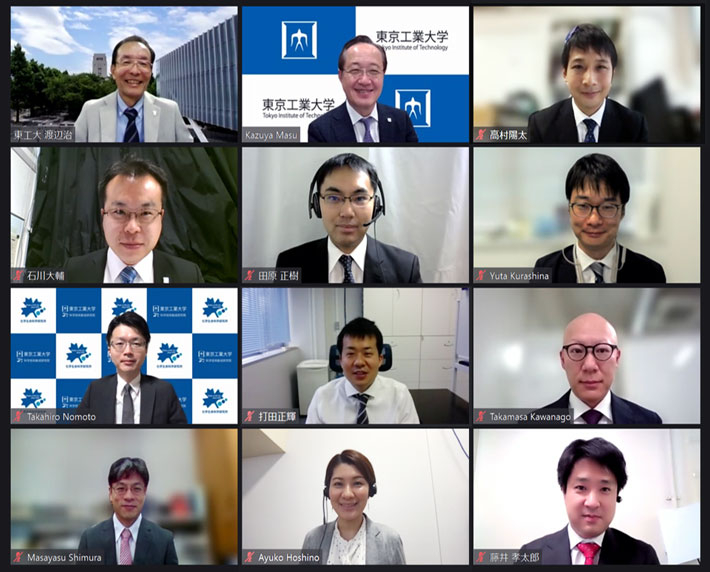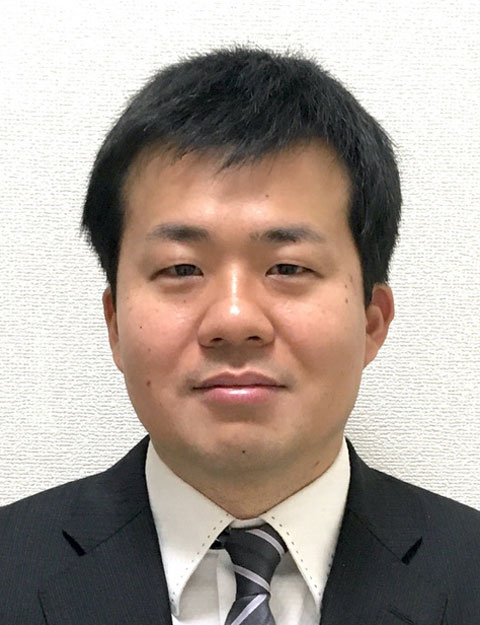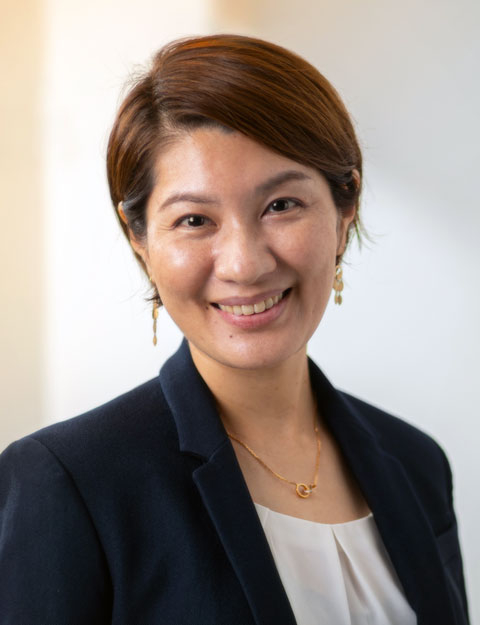Life Science and Technology News
2021 Tokyo Tech Challenging Research Award Winners Announced
Tokyo Institute of Technology (Tokyo Tech) announced on June 18, 2021, ten winners of the 20th Tokyo Tech Challenging Research Awards. Three of the awardees were also selected for the Suematsu Challenging Research Awards for outstanding research. The award ceremony was held on July 28 via online video conference.

(From top left) Executive Vice President for Research Watanabe, President Masu, and ten award winners
Tokyo Tech established the Challenging Research Award with the aim of encouraging young faculty members at the Institute to engage in challenging research. It recognizes creative, up-and-coming researchers who boldly pursue the promotion of the most advanced research in the world, pioneering of new fields of study, innovative development of new research, and important issues that are difficult to solve.
The Suematsu Challenging Research Award is given to the highest qualified researchers among the Challenging Research Award winners. This award was established by the "Suematsu Fund", which was created based on the desire of former President Yasuharu Suematsu to support young researchers. When Professor Yasuharu Suematsu received the Japan Prize![]() in 2014, he donated a portion of the prize money to Tokyo Tech, which established the Suematsu Fund to encourage young researchers. The Fund supports mainly young researchers to encourage their research activities to predict and study the development of unexplored scientific and technological systems in diverse fields and to bring the potential future to real society.
in 2014, he donated a portion of the prize money to Tokyo Tech, which established the Suematsu Fund to encourage young researchers. The Fund supports mainly young researchers to encourage their research activities to predict and study the development of unexplored scientific and technological systems in diverse fields and to bring the potential future to real society.
This year, The Suematsu Challenging Research Award was awarded to Associate Professor Masaki Uchida, Department of Physics, School of Science; Associate Professor Ayuko Hoshino, Department of Life Science and Technology, School of Life Science and Technology; and Associate Professor Masaki Tahara, Laboratory for Materials and Structures, Institute of Innovative Research.
2021 Tokyo Tech Challenging Research Award Recipients
| Name | Affiliation | Title | Research Topic * Granted Suematsu Challenging Research Award |
|---|---|---|---|
| Associate Professor | * Establishing scientific theory of novel quantum transport based on chiral zero mode | ||
| Assistant Professor | Exploration of novel ionic conductors based on structure science | ||
| Associate Professor | Development of plasma assisted turbulent combustor based on characteristics of combustion oscillation transition | ||
| Assistant Professor | Superconducting spin valve Josephson Junction | ||
| Assistant Professor | High sensitivity acoustic responsive microdevice for drug release | ||
| Assistant Professor | Nanoscale ORIGAMI at two-dimensional interfaces | ||
| Associate Professor | * Role of maternal-derived exosomes in embryonic brain development | ||
|
Laboratory for Future Interdisciplinary Research of Science and Technology |
Assistant Professor | Demonstration of High Gain CMOS Inverter at 0.5 V operation Based on WSe2 FET | |
| Associate Professor | * Research on stress-induced phase transformation in shape memory alloy | ||
| Assistant Professor | Development of innovative drug delivery systems utilizing amino acid transporters and systematic analysis of associated factors affecting intravital microenvironment |
Comments from the Suematsu Challenging Research Award winners
Masaki UCHIDA
Associate Professor, Department of Physics, School of Science

We have succeeded in producing a thin film of topological semimetal with extremely high crystallinity by developing our own film growth technique, and have paved the way for research of its quantum transport. In particular, we have succeeded in observing the surface conduction and its quantum Hall state in a topological semimetal film for the first time. Furthermore, our recent experiments using the field effect have shown that this surface quantum Hall state connects the front and back surfaces of the thin film. This means that two spatially separated surface orbit states are coupled by a completely new electronic structure called "chiral zero mode". It is expected that new dissipationless conduction along the out-of-plane direction and demonstration of a new quantum correlation phenomenon in two spatially separated planes will be demonstrated by further research.
Finally, I am very honored to receive this award. We would like to express our sincere gratitude to all the advisers, collaborators, and students, and we deeply appreciate the great support of our university for young researchers.
- Uchida Laboratory
- Masaki Uchida Website
- Unusual Semimetal Shows Evidence of Unique Surface Conduction States | Tokyo Tech News
Ayuko HOSHINO
Associate Professor, Department of Life Science and Technology, School of Life Science and Technology

Exosomes are nanovesicles produced by all cells and were originally recognized as a waste disposal mechanism, however most recently it has become clear that they are involved in intercellular communication. We have reported that cancer cell-derived exosomes are involved in determining the future site of metastasis, and that plasma-derived exosomes can be used for diagnosis and identification of cancer types. Currently, our lab is also interested in investigating how exosomal cargo changes in response to pathological conditions such as autism, Alzheimer's disease, and pregnancy complications, and to elucidate how it relates to disease progression. The research topic that led to this award aims to demonstrate that maternal-derived exosomes are taken up by the fetus, and to elucidate how it influences the fetal brain development.
I am very honored to receive the prestigious Tokyo Tech Challenging Research Award and the Suematsu Challenging Research Award. I would like to take this opportunity to express my heartfelt gratitude to Dr. Kondo and the many other professors and laboratory members who have supported my research life.
- Hoshino Laboratory
- Tiny Protein Packages Released from Cells May Serve as Biomarkers for Early Blood-Based Cancer Diagnosis
- Exosomes and their role in how cancer spreads
Masaki TAHARA
Associate Professor, Laboratory for Materials and Structures, Institute of Innovative Research

I am very honored to receive this award. I greatly appreciate the support of Professor Hideki Hosoda, Professor Tomonari Inamura, all of my collaborators, and laboratory members.
Shape memory alloys are functional metallic materials developed in Japan and are used in various applications by taking advantage of their ability to recover their initial shape even when a large strain exceeding the elastic limit is applied. Recently, shape memory alloys have received more and more attention in the field of metal materials. The reason is that the performance of existing Ti-Ni alloys is improving, and the development of new alloys specialized for specific applications such as biomedical, high temperature, and vibration damping is becoming active worldwide. The unique mechanical functionality of shape memory alloys is brought about by a non-diffusional structural phase transformation called the martensitic transformation. In particular, the martensitic transformation induced by external stress plays a central role in the functionality of shape memory alloys; however, its basic understanding is not sufficient. This research aims to establish the basic knowledge by clarifying the stress-induced phase transformation behavior of shape memory alloys by combining various in-situ measurement techniques.
Related Links
- Challenging Research Award | Office of Research and Innovation
- 2020 Tokyo Tech Challenging Research Award | Tokyo Tech News
- 2019 Tokyo Tech Challenging Research Award | Tokyo Tech News
Tokyo Institute of Technology iGEM is supported by Tokyo Tech Fund






